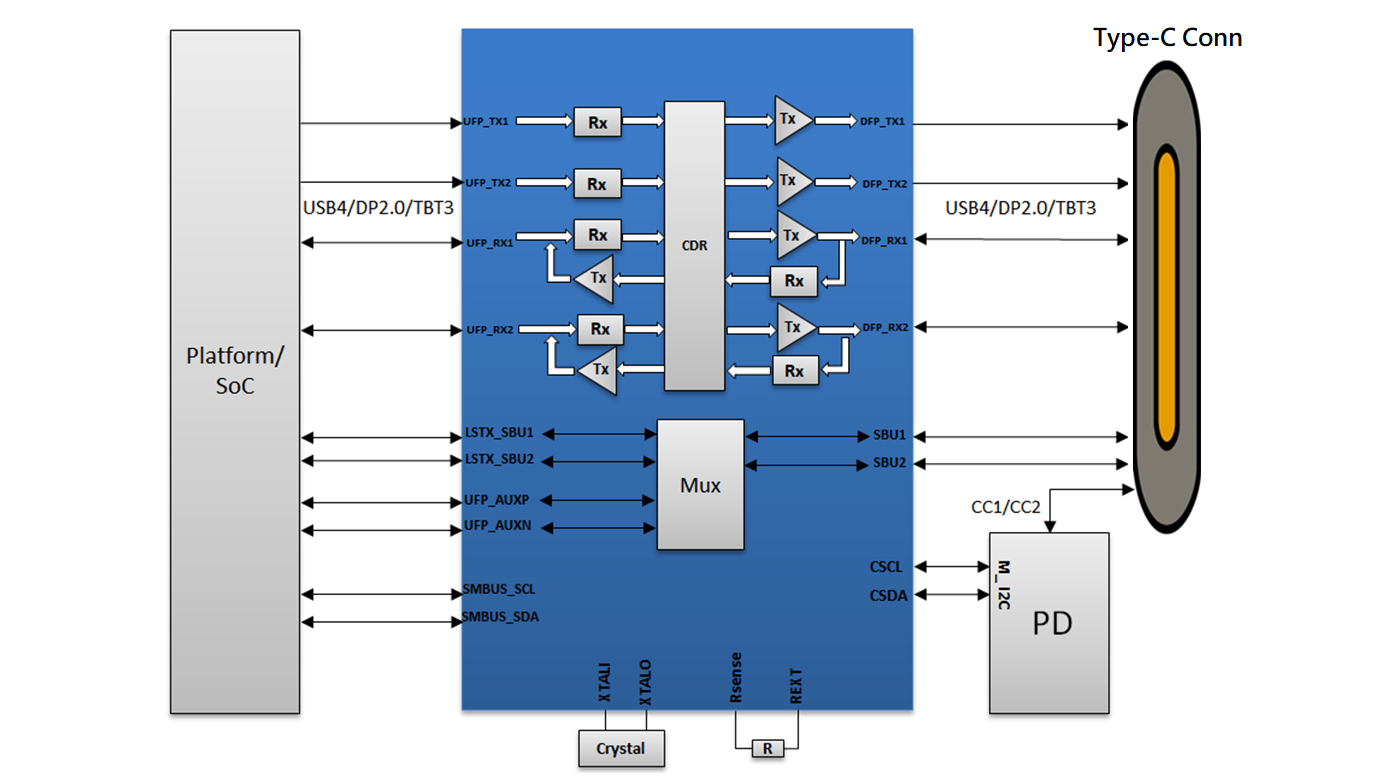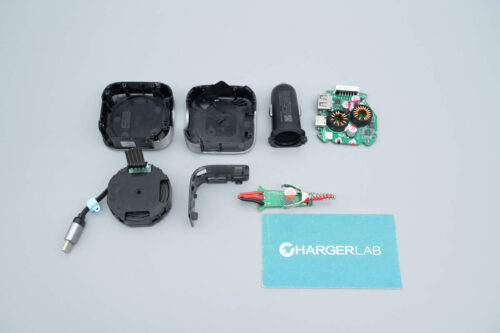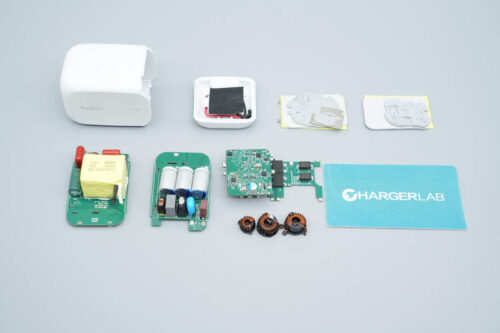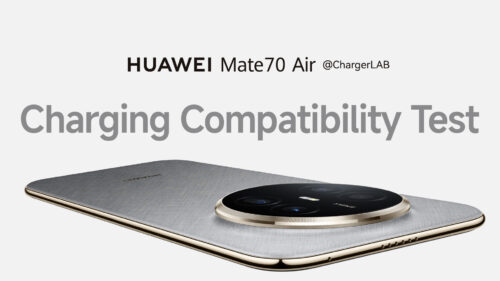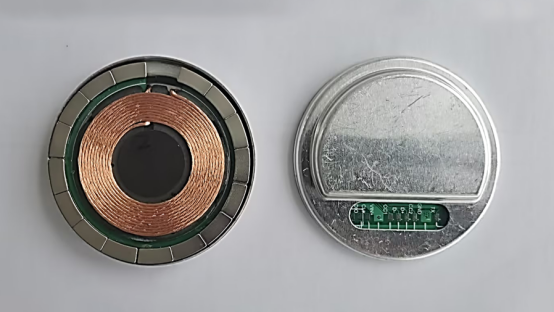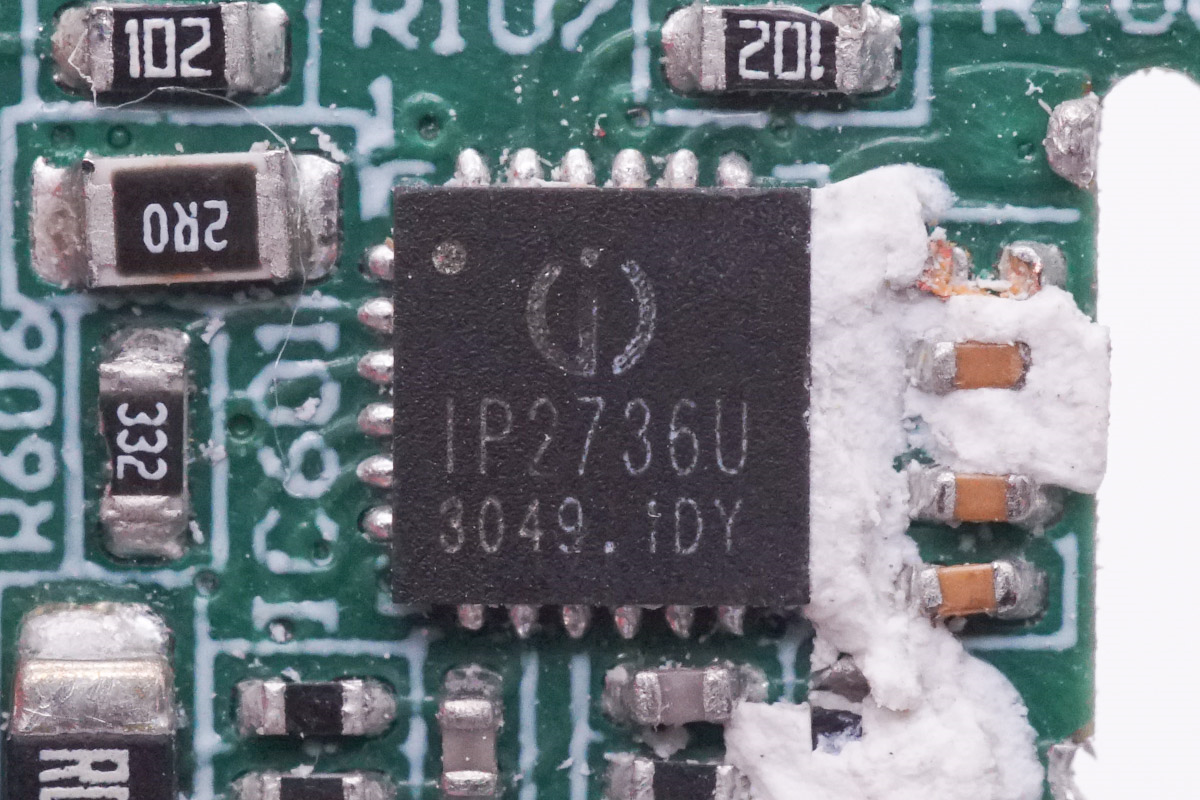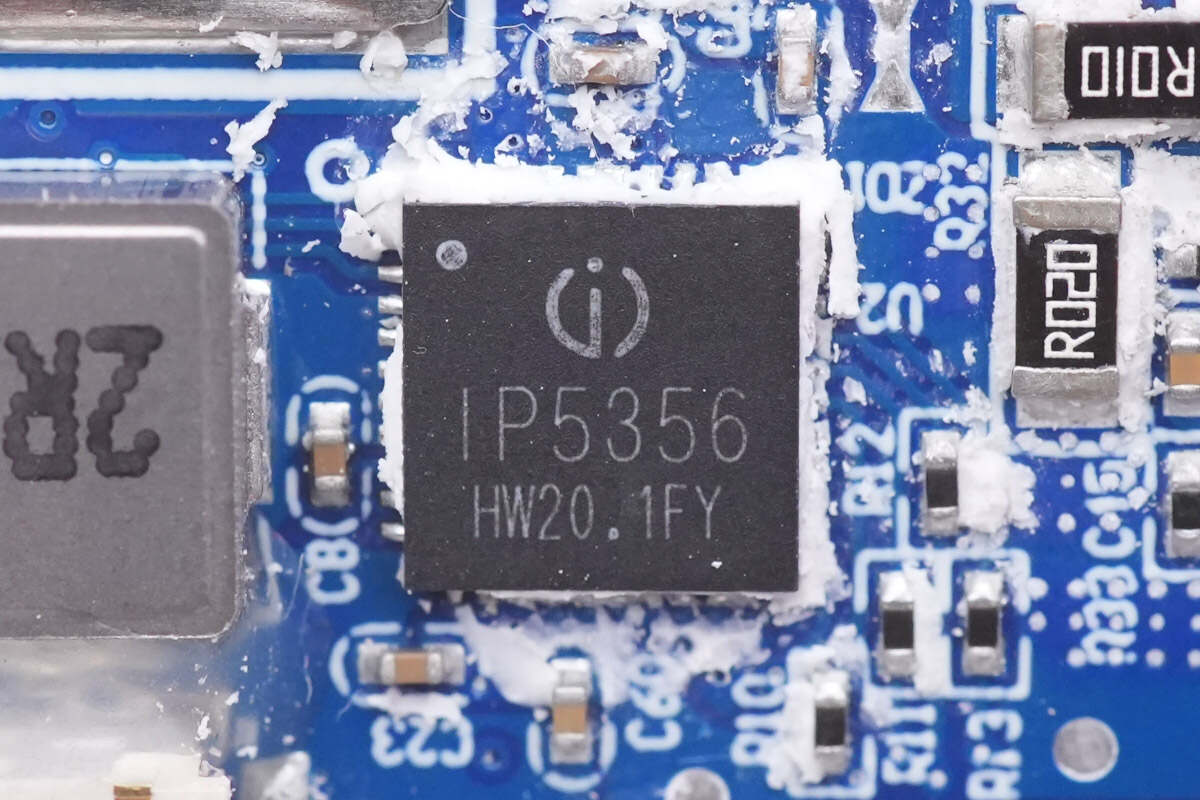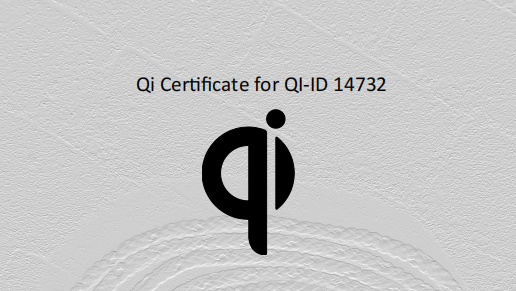Introduction
ChargerLAB's followers should still remember that we wrote an article about the iPhone 15's USB-C port and the revelation of a mystery chip before this year's Apple Event. This chip is the Retimer, which is a hybrid device for digital and analog signals, with sensing capabilities to fully recover and retransmit data signals. Specifically, it extracts the embedded clock in the input signal using its internal Clock and Data Recovery (CDR), and then uses an undistorted clock signal to retransmit data, creating a new copy of the original data signal.
After the launch of PCIe 4.0, due to the increase in frequency, signal degradation occurs quickly, and the eye pattern quickly closes after a short distance. To increase the transmission distance, the signal must be strengthened. So, the Retimer is actually a signal booster chip, similar to a Re-driver but with some differences. You can see it as a signal repeater that enhances the Rx and Tx of Thunderbolt technology, allowing them to transmit over longer distances on the motherboard.
Additionally, Retimers ensure high-speed signal transmission and data integrity for USB4 connections. These chips are specifically designed for tasks such as signal retiming and extending the transmission distance to maintain the performance and reliability of USB4 connections. They can be installed at either end or in the middle of a USB4 connection to ensure that the signal is properly processed and enhanced during transmission, effectively supporting high-speed data transfer and display requirements.
About USB4
The USB data transfer protocol was introduced much earlier than USB PD. In fact, USB 1.0 was introduced in 1996, which was the third year of the USB-IF's establishment. The first generation of the USB standard had a transfer rate of only 1.5 Mbps.
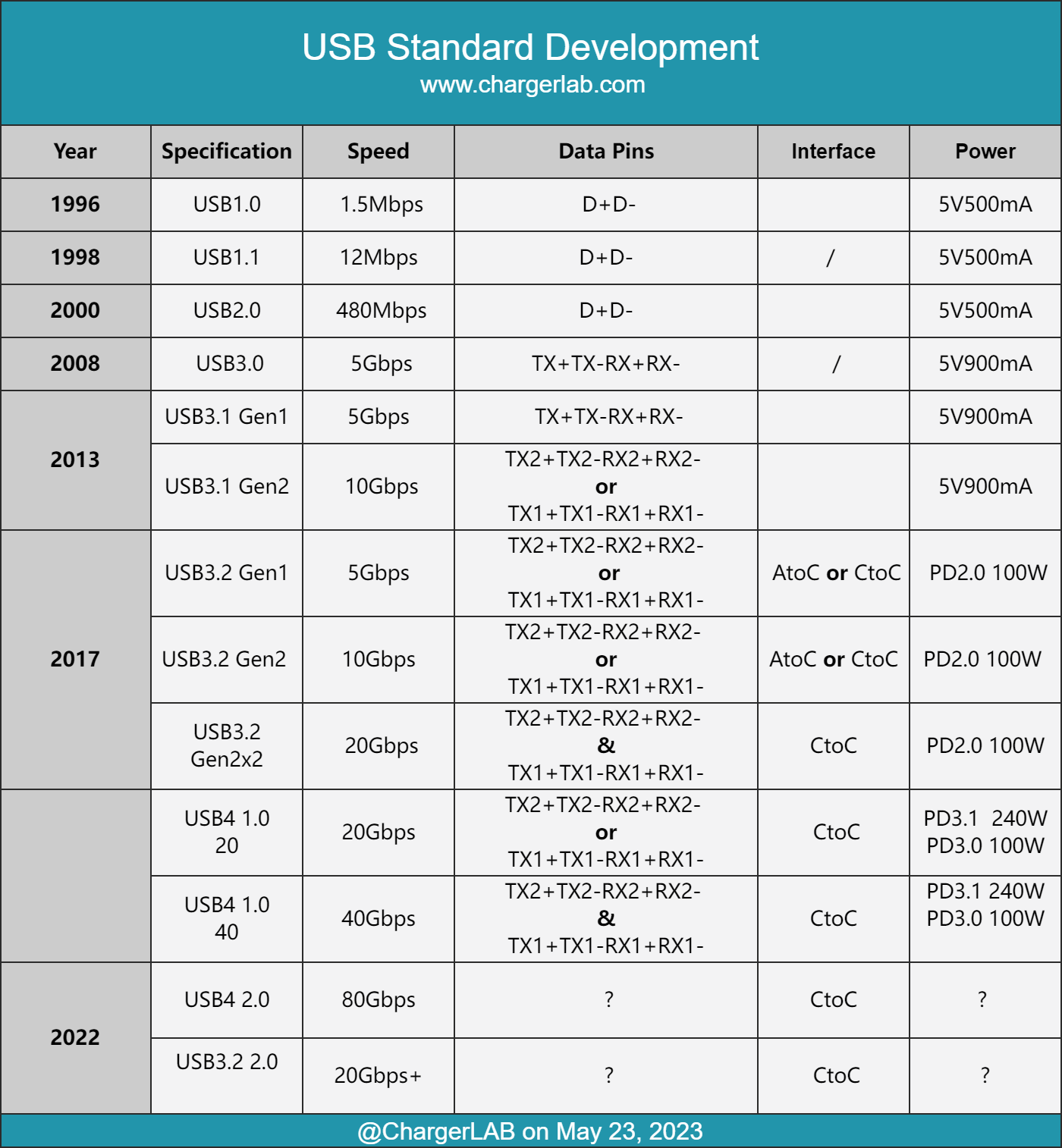
In September 2019, USB4 was officially released with a maximum transfer rate of 40 Gbps, the same as Thunderbolt 3. USB4 has two specifications: USB4 40 with 40 Gbps and USB4 20 with 20 Gbps.
In September 2022, the USB4 2.0 standard was exposed, raising the maximum speed to 80 Gbps. It also adopted a new data architecture, updating the USB PD fast charging standard and the USB-C port and cable standard simultaneously.
USB has come a long way from its initial 1.5 Mbps to the high-speed USB4 2.0, reaching up to 80 Gbps. This transformation is primarily due to an increase in the number of data transmission channels. Specifically, the 2013 upgrade increased the number of differential channels to four pairs and introduced the more capable USB-C port.
While the latest iPhone 15 Pro series is only equipped with a port equivalent to USB 3.2 Gen 1 from 2017, this is still one of the most significant advancements in the iPhone's charging port. It is expected that Apple will build on this foundation to deliver higher-performance USB-C ports in the future.
USB4 ReTimer
Intel
JHL9020R
Intel JHL9020R is a retimer or redriver that supports USB4 and one USB4 port (10.0/10.3 Gbps).
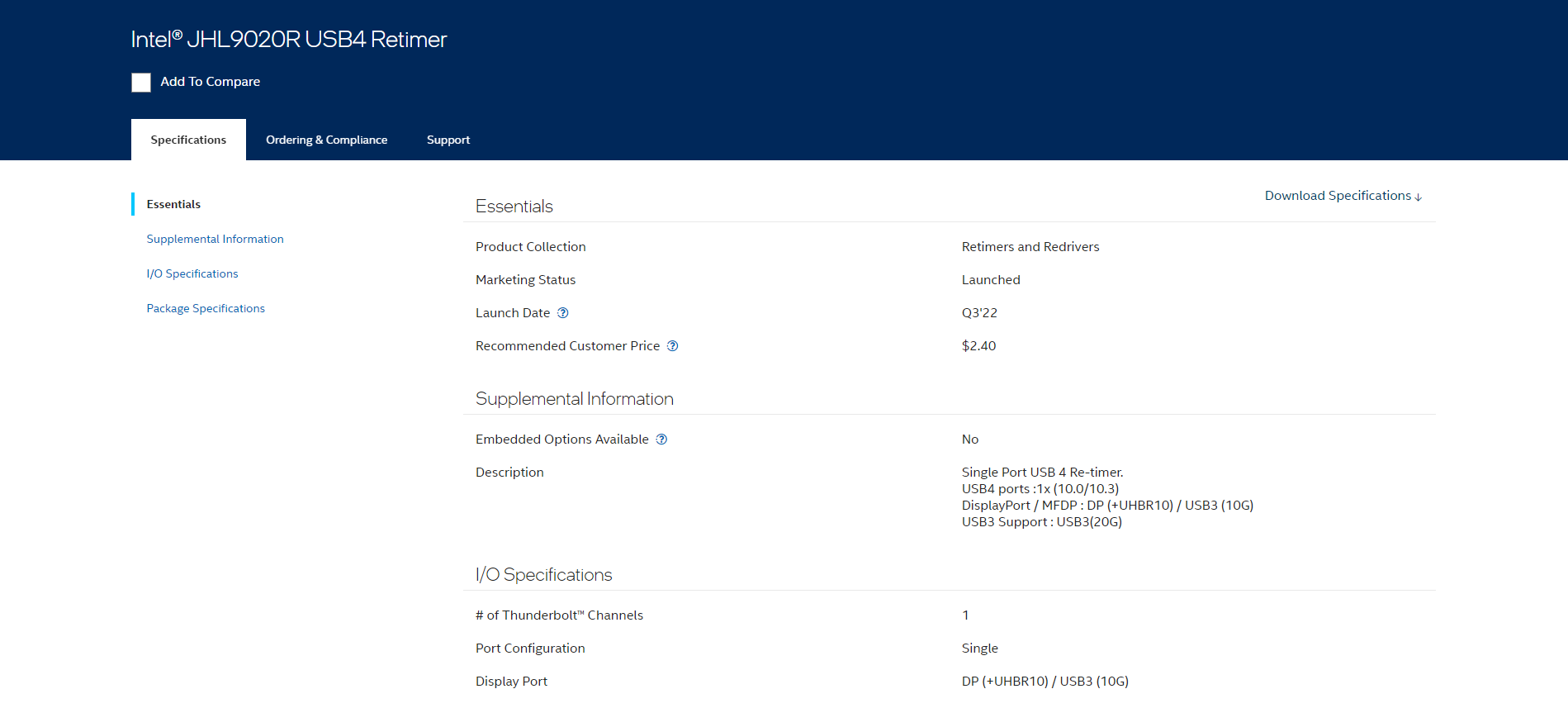
It also supports DisplayPort and MFDP, featuring DP (up to UHBR10) and USB3 (10G) functionality, as well as USB3 support with speeds of up to 20 Gbps.
Nuvoton
KM864741
KM864741 is a multi-protocol bidirectional Re-Timer for USB-C cables. It supports USB4 and is backward compatible with Thunderbolt 3, USB3.2, DP2.1, and DisplayPort Alt mode.
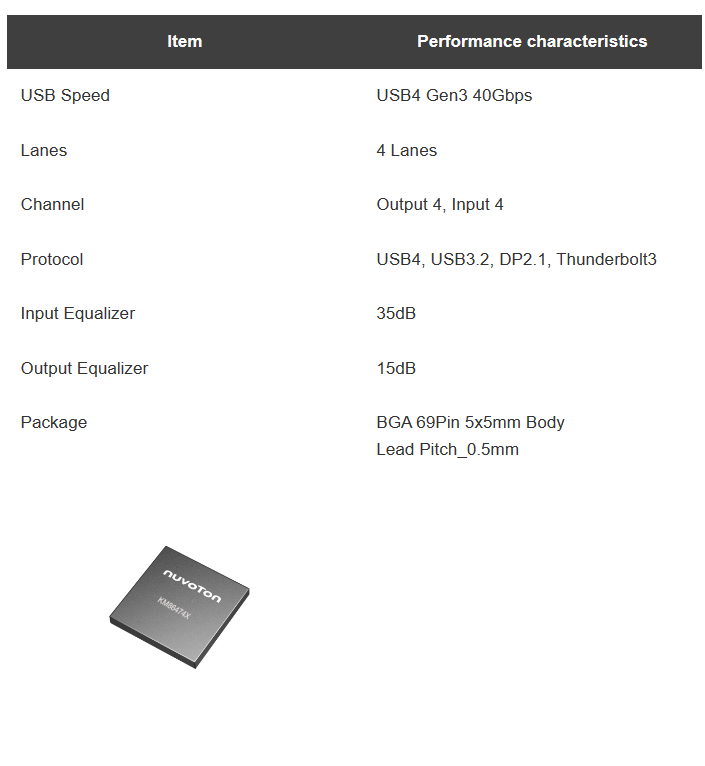
It has four parallel transmission channels and provides signal loss compensation on the receiving end (up to 35dB) and emphasis circuit on the transmitting end (up to 15dB). And the CPU and connectors within the device can be arranged freely, achieving flexible circuit board design.
KM864741 adopts a BGA package with 69 pins, dimensions of 5x5 millimeters, and a pin pitch of 0.5 millimeters. It is typically used in PCs, tablet displays, smartphones, game consoles, docking stations, and more.
KM864742
KM864742 is another multi-protocol bidirectional Re-Timer designed specifically for USB-C cables. It supports USB4 40, meaning it can provide an active cable Re-Timer solution that can transmit and receive up to 40Gbps. It is also backward compatible with Thunderbolt 3, USB3.2, DP2.1, and DisplayPort Alt mode.
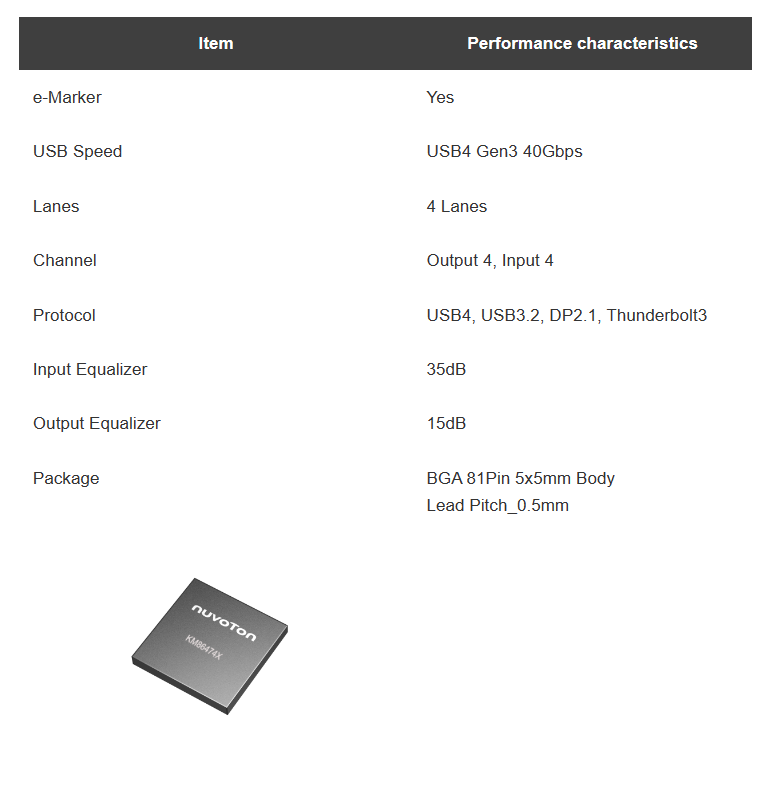
Similar to KM864741, KM864742 features four parallel transmission channels, equalizers, and emphasis circuits with specs similar to the previous model. However, what sets it apart is its ability to implement a high-quality, cost-effective cable thinning technology, significantly alleviating restrictions on cable skew at the input end of the Re-Timer.
In addition to reducing material costs and Paddle card installation costs, it can also shrink the diameter of metal wires to be similar to optical fibers, improving usability. Furthermore, the built-in E-marker simplifies design, reduces the bill of materials (BOM), and shortens the software development cycle.
KM864742 adopts a BGA package with 81 pins, dimensions of 5x5 millimeters, and a pin pitch of 0.5 millimeters. It is suitable for various applications, including USB4 cables.
Parade
PS8830
PS8830 is a Re-Timer designed for host platforms supporting USB4, DP 2.0, and Thunderbolt 3.0. It complies with USB4 and USB 3.2 specifications, along with relevant USB-IF specifications, including support for repeaters and alternate mode. It also complies with the VESA DisplayPort's alternate mode on the USB Type-C® 2.0 standard.
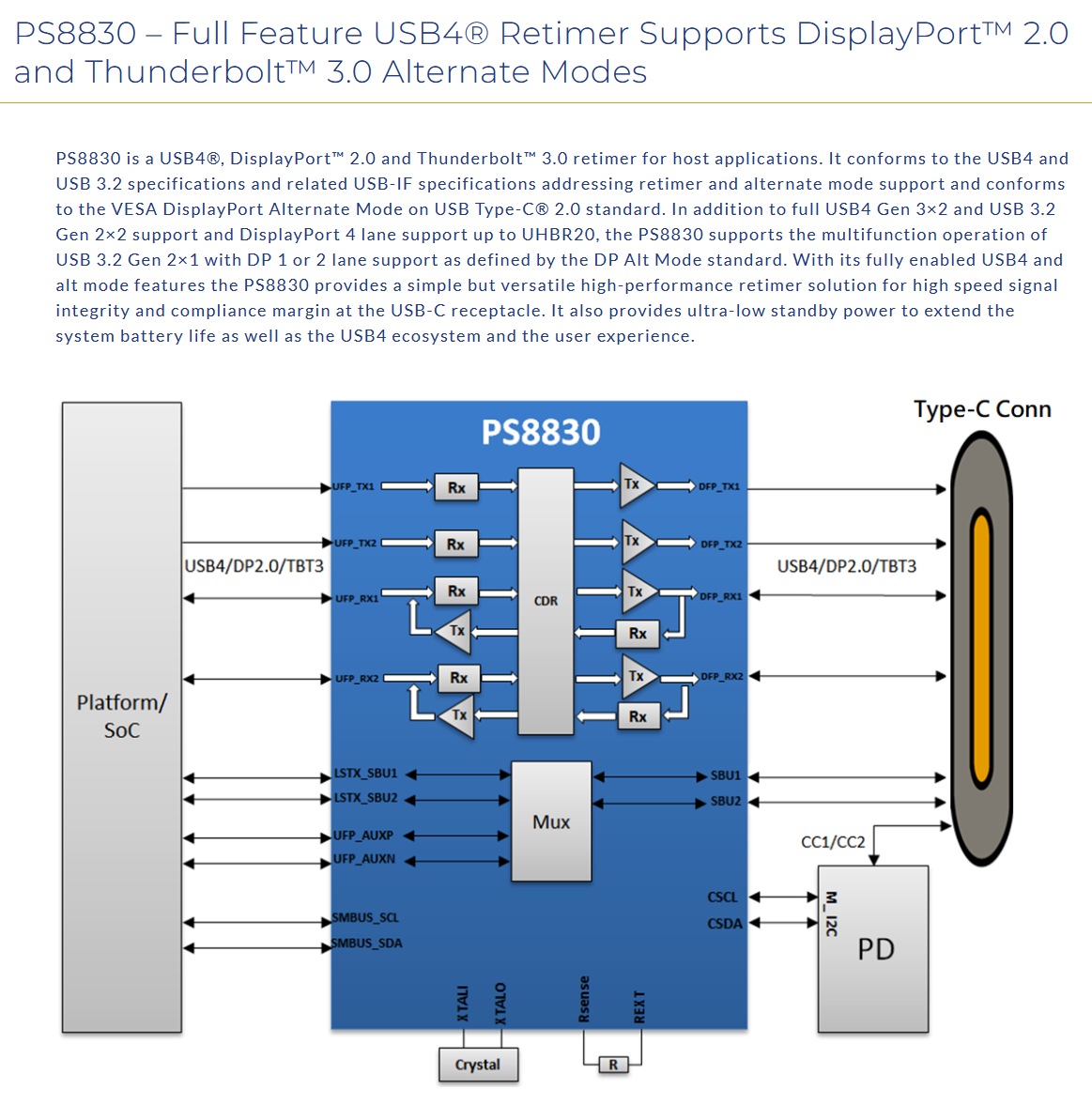
It supports USB4 Gen 3×2 and USB 3.2 Gen 2×2, along with DisplayPort 4-channel support at UHBR20 speeds. PS8830 also supports multi-functional operations for USB 3.2 Gen 2×1, equipped with DP 1 or 2-channel support, as defined by the DP Alt Mode standard.
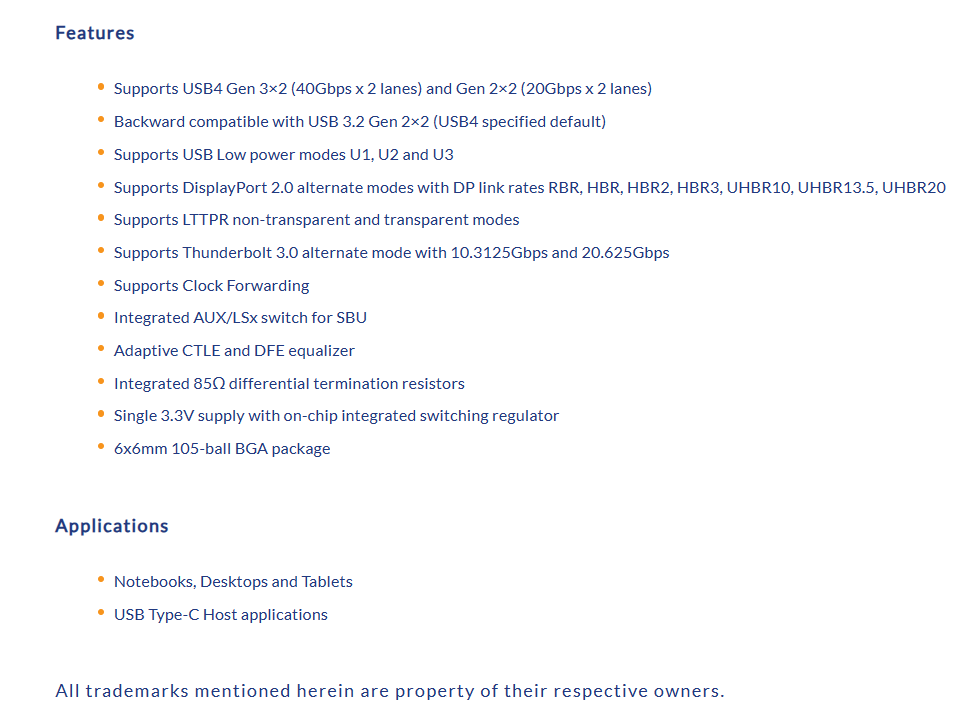
With its fully enabled USB4 and alternate mode capabilities, PS8830 provides a simple, versatile, high-performance repeater solution for USB-C sockets, ensuring high-speed signal integrity and compatibility. It also offers ultra-low standby power consumption, extending system battery life, and improving the USB4 ecosystem and user experience.
PS8833
PS8833 is another Re-Timer designed for host platforms, supporting USB4, DisplayPort 2.1, and Thunderbolt 4. It complies with USB4 and USB 3.2 specifications and adheres to the VESA DisplayPort's alternate mode on the USB Type-C® 2.0 standard.
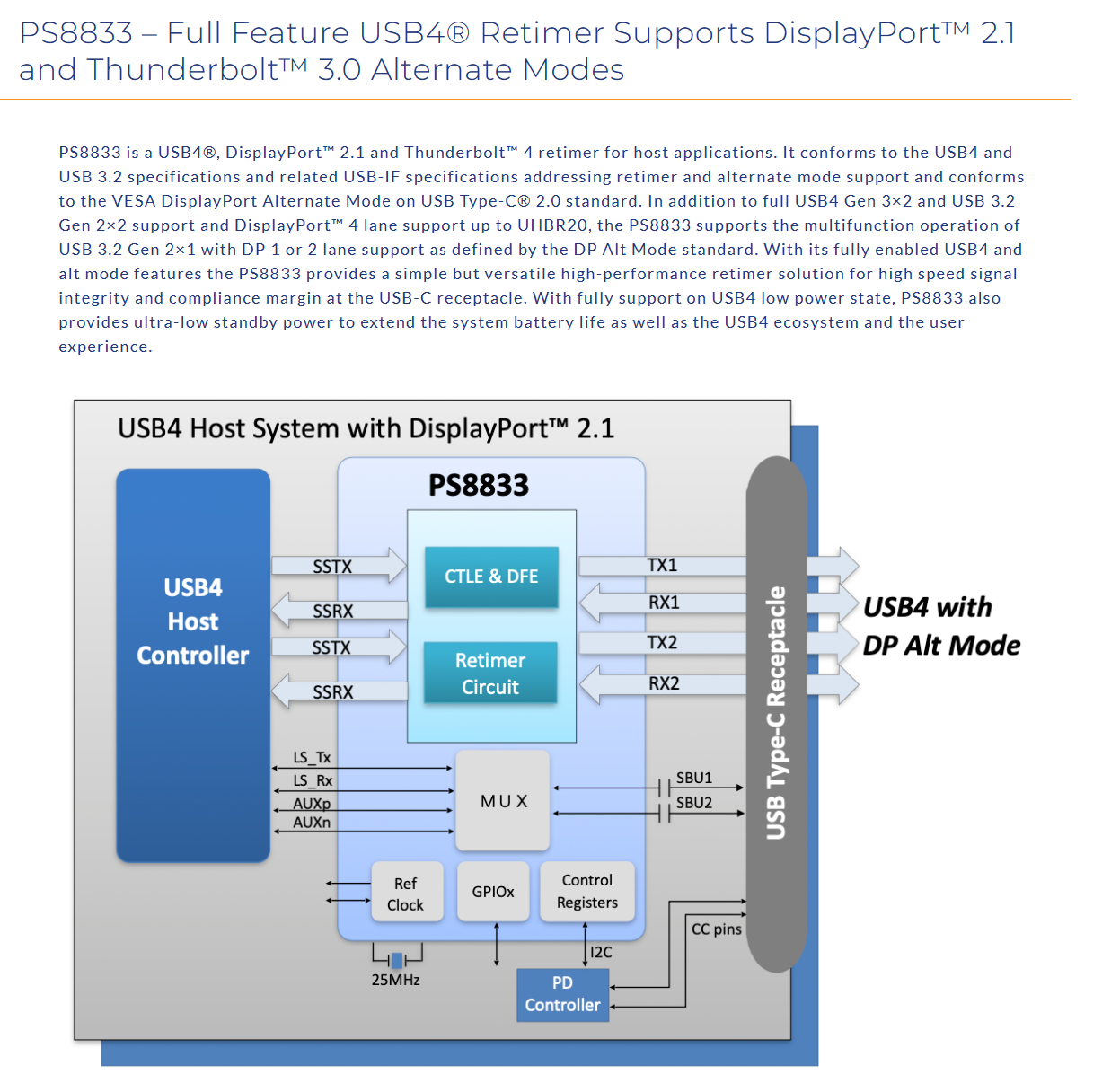
It offers comprehensive support for USB4 Gen 3×2, USB 3.2 Gen 2×2, and DisplayPort™ 4-channel, reaching speeds up to UHBR20. PS8833 also supports USB 3.2 Gen 2×1 and DP 1 or 2-channel support. With its fully enabled USB4 and alternate mode capabilities, it provides a simple, versatile, high-performance repeater solution for USB-C sockets, ensuring high-speed signal integrity and compatibility.
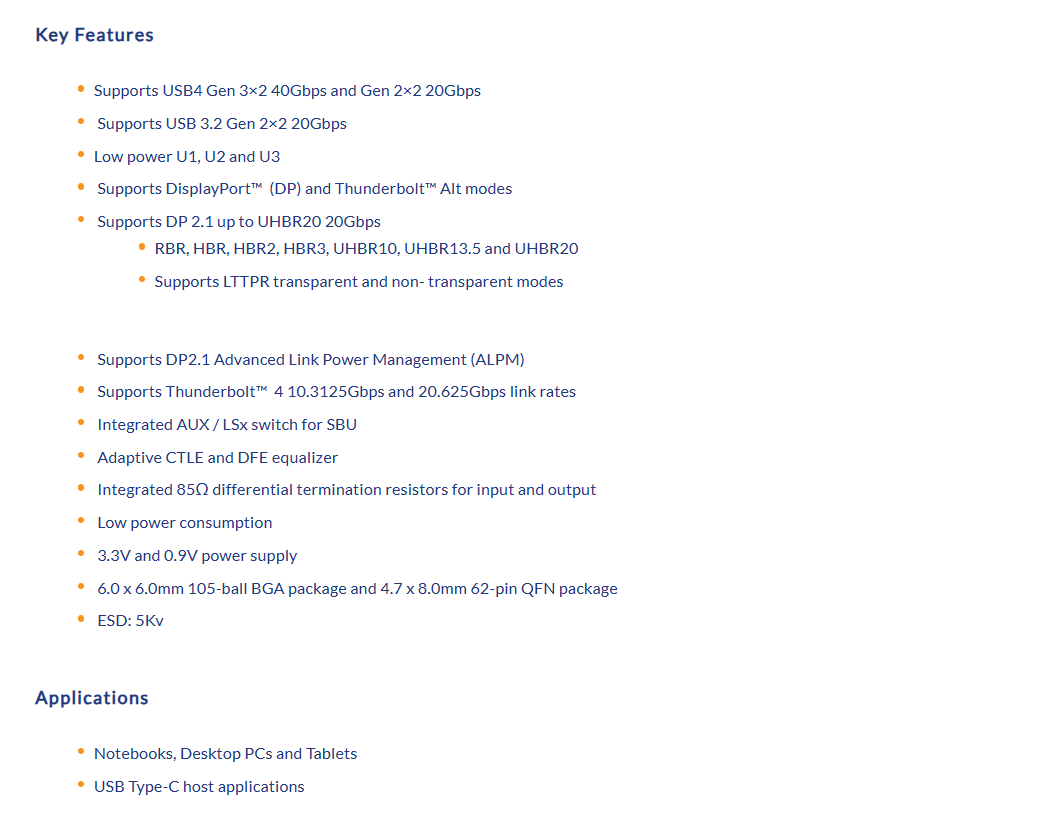
PS8833 provides comprehensive support for low-power states of USB4, along with ultra-low standby power consumption, extending system battery life, and improving the USB4 ecosystem and user experience.
Summary of ChargerLAB
USB4 is a high-speed communication standard, supporting data transfer speeds of up to 40Gbps, with the latest USB4 2.0 even reaching 80Gbps. This makes it an ideal choice for connecting computers, peripheral devices, and displays. This is also why the iPhone 15 Pro series adopted USB 3.0. However, high-speed communication standards are often limited by signal timing jitter and transmission distance, which require special electronic components to address.
USB4 ReTimers can detect the timing of USB4 signals and extend the signal's transmission distance while adjusting it during transmission. This helps reduce signal jitter while maintaining data integrity, all contributing to enhanced data reliability.
The five chips summarized by ChargerLAB comprehensively support high-speed USB4 standard data transfer of up to 40Gbps, compatible with multiple protocols, including USB, Thunderbolt, DP, ensuring accurate signal handling during transmission. They are currently leading USB4 connectivity solutions.

